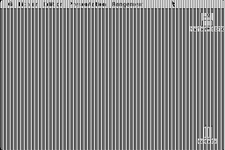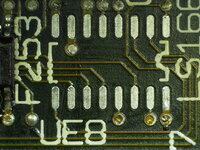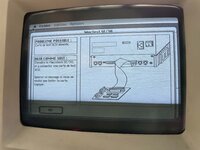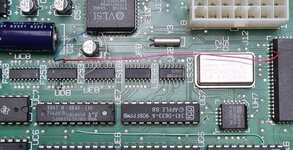pgreenland
Well-known member
Hi All,
I've recently joined the classic mac owners club, with three fixer upper SE/30's in various states of decay.
Having selected the best logic board of the three, with no leaking caps or exploded battery. I've cleaned and recapped it. Not yet recapped the analog board or PSU but have checked the rail voltages, which all seem pretty close.
It boots happily from floppy to MacTest SE/30 and seemingly passes all the tests which don't require additional hardware (serial loopback cable for example).
There's something funky going on with the video hardware or CRT that I was hoping someone might be able to give me some pointers on.
Here's the CRT at the MacTest desktop.

The desktop is visible under whatever's going on. Of the three systems I have two CRTs that work and display largely the same thing.
I dropped a logic analyser on the video, hsync and vsync signals and wrote a bit of software to decode them.
Leading to the following:

It could well be my questionable quality python, but there are similarities between what's shown on the CRT and the image extracted from the raw video signal present on J12.
Thought there might be an issue further upstream, so moved to the video ram data lines, shift register load line and vsync. Some minor python adjustments and I ended up with:

To my amazement the video ram does indeed contain a valid image.
So I'm thinking the problem lies somewhere between the video ram and the signals present on J12 for the CRT. As well as possible other problems on the analog board that I've got even less knowledge on than the video generation hardware.
Any pointers / advice would be much appreciated.
Thanks,
Phil
I've recently joined the classic mac owners club, with three fixer upper SE/30's in various states of decay.
Having selected the best logic board of the three, with no leaking caps or exploded battery. I've cleaned and recapped it. Not yet recapped the analog board or PSU but have checked the rail voltages, which all seem pretty close.
It boots happily from floppy to MacTest SE/30 and seemingly passes all the tests which don't require additional hardware (serial loopback cable for example).
There's something funky going on with the video hardware or CRT that I was hoping someone might be able to give me some pointers on.
Here's the CRT at the MacTest desktop.

The desktop is visible under whatever's going on. Of the three systems I have two CRTs that work and display largely the same thing.
I dropped a logic analyser on the video, hsync and vsync signals and wrote a bit of software to decode them.
Leading to the following:

It could well be my questionable quality python, but there are similarities between what's shown on the CRT and the image extracted from the raw video signal present on J12.
Thought there might be an issue further upstream, so moved to the video ram data lines, shift register load line and vsync. Some minor python adjustments and I ended up with:

To my amazement the video ram does indeed contain a valid image.
So I'm thinking the problem lies somewhere between the video ram and the signals present on J12 for the CRT. As well as possible other problems on the analog board that I've got even less knowledge on than the video generation hardware.
Any pointers / advice would be much appreciated.
Thanks,
Phil






